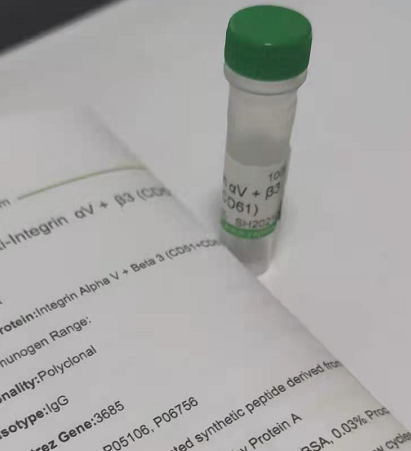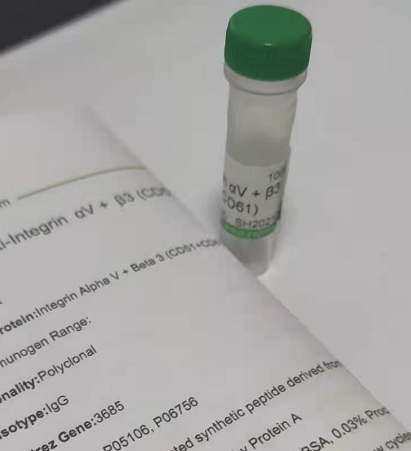| 產(chǎn)品編號(hào) | Ys-1157R |
| 英文名稱 | Fibrillin 1 |
| 中文名稱 | 原纖維蛋白1抗體 |
| 別 名 | fibrillin1; 350 kDa glycoprotein component extracellular microfibril; FBN 1; FBN1; FBN; Fibrillin 15; Fibrillin15; Marfan syndrome; MASS; MFS 1; MFS1; OCTD; SGS; Weill Marchesani syndrome; WMS; AI536462; B430209H23; Fib-1; Fibrilin-1; ACMICD; FBN1_HUMAN; GPHYSD2; SSKS; Weill Marchesani syndrome; WMS2. |
| 抗體來源 | Rabbit |
| 克隆類型 | Polyclonal |
| 交叉反應(yīng) | Human, Rat, (predicted: Mouse, ) |
| 產(chǎn)品應(yīng)用 | ELISA=1:5000-10000 IHC-P=1:100-500 IHC-F=1:100-500 IF=1:100-500 (石蠟切片需做抗原修復(fù)) not yet tested in other applications. optimal dilutions/concentrations should be determined by the end user. |
| 理論分子量 | 316kDa |
| 細(xì)胞定位 | 細(xì)胞外基質(zhì) |
| 性 狀 | Liquid |
| 濃 度 | 1mg/ml |
| 免 疫 原 | KLH conjugated synthetic peptide derived from human FBN1: 401-500/2872 |
| 亞 型 | IgG |
| 純化方法 | affinity purified by Protein A |
| 緩 沖 液 | 0.01M TBS(pH7.4) with 1% BSA, 0.03% Proclin300 and 50% Glycerol. |
| 保存條件 | Shipped at 4℃. Store at -20 °C for one year. Avoid repeated freeze/thaw cycles. |
| 注意事項(xiàng) | This product as supplied is intended for research use only, not for use in human, therapeutic or diagnostic applications. |
| PubMed | PubMed |
| 產(chǎn)品介紹 | This gene encodes a member of the fibrillin family. The encoded protein is a large, extracellular matrix glycoprotein that serve as a structural component of 10-12 nm calcium-binding microfibrils. These microfibrils provide force bearing structural support in elastic and nonelastic connective tissue throughout the body. Mutations in this gene are associated with Marfan syndrome, isolated ectopia lentis, autosomal dominant Weill-Marchesani syndrome, MASS syndrome, and Shprintzen-Goldberg craniosynostosis syndrome. [provided by RefSeq, Jul 2008] Function: Fibrillins are structural components of 10-12 nm extracellular calcium-binding microfibrils, which occur either in association with elastin or in elastin-free bundles. Fibrillin-1-containing microfibrils provide long-term force bearing structural support. Regulates osteoblast maturation by controlling TGF-beta bioavailability and calibrating TGF-beta and BMP levels, respectively. Subcellular Location: Secreted, extracellular space, extracellular matrix. Post-translational modifications: Forms intermolecular disulfide bonds either with other fibrillin-1 molecules or with other components of the microfibrils. DISEASE: Defects in FBN1 are a cause of Marfan syndrome (MFS) [MIM:154700]. MFS is an autosomal dominant disorder that affects the skeletal, ocular, and cardiovascular systems. A wide variety of skeletal abnormalities occurs with MFS, including scoliosis, chest wall deformity, tall stature, abnormal joint mobility. Ectopia lentis occurs in up to about 80% of MFS patients and is almost always bilateral. The leading cause of premature death in MFS patients is progressive dilation of the aortic root and ascending aorta, causing aortic incompetence and dissection. Note=The majority of the more than 600 mutations in FBN1 currently known are point mutations, the rest are frameshifts and splice site mutations. Marfan syndrome has been suggested in at least 2 historical figures, Abraham Lincoln and Paganini. Defects in FBN1 are a cause of isolated ectopia lentis (EL) [MIM:129600]. The symptoms of this autosomal dominant fibrillinopathy overlap with those of Marfan syndrome, with the exclusion of the skeletal and cardiovascular manifestations. Defects in FBN1 are the cause of Weill-Marchesani syndrome autosomal dominant (ADWMS) [MIM:608328]. A rare connective tissue disorder characterized by short stature, brachydactyly, joint stiffness, and eye abnormalities including microspherophakia, ectopia lentis, severe myopia and glaucoma. Defects in FBN1 are a cause of Shprintzen-Goldberg craniosynostosis syndrome (SGS) [MIM:182212]. SGS is a very rare syndrome characterized by a marfanoid habitus, craniosynostosis, characteristic dysmorphic facial features, skeletal and cardiovascular abnormalities, mental retardation, developmental delay and learning disabilities. Defects in FBN1 are a cause of overlap connective tissue disease (OCTD) [MIM:604308]. A heritable disorder of connective tissue characterized by involvement of the mitral valve, aorta, skeleton, and skin. MASS syndrome is closely resembling both the Marfan syndrome and the Barlow syndrome. However, no dislocation of the lenses or aneurysmal changes occur in the aorta, and the mitral valve prolapse is by no means invariable. Defects in FBN1 are a cause of stiff skin syndrome (SSKS) [MIM:184900]. It is a syndrome characterized by hard, thick skin, usually over the entire body, which limits joint mobility and causes flexion contractures. Other occasional findings include lipodystrophy and muscle weakness. Similarity: Belongs to the fibrillin family. Contains 47 EGF-like domains. Contains 9 TB (TGF-beta binding) domains. SWISS: |
我要詢價(jià)
*聯(lián)系方式:
(可以是QQ、MSN、電子郵箱、電話等,您的聯(lián)系方式不會(huì)被公開)
*內(nèi)容:









